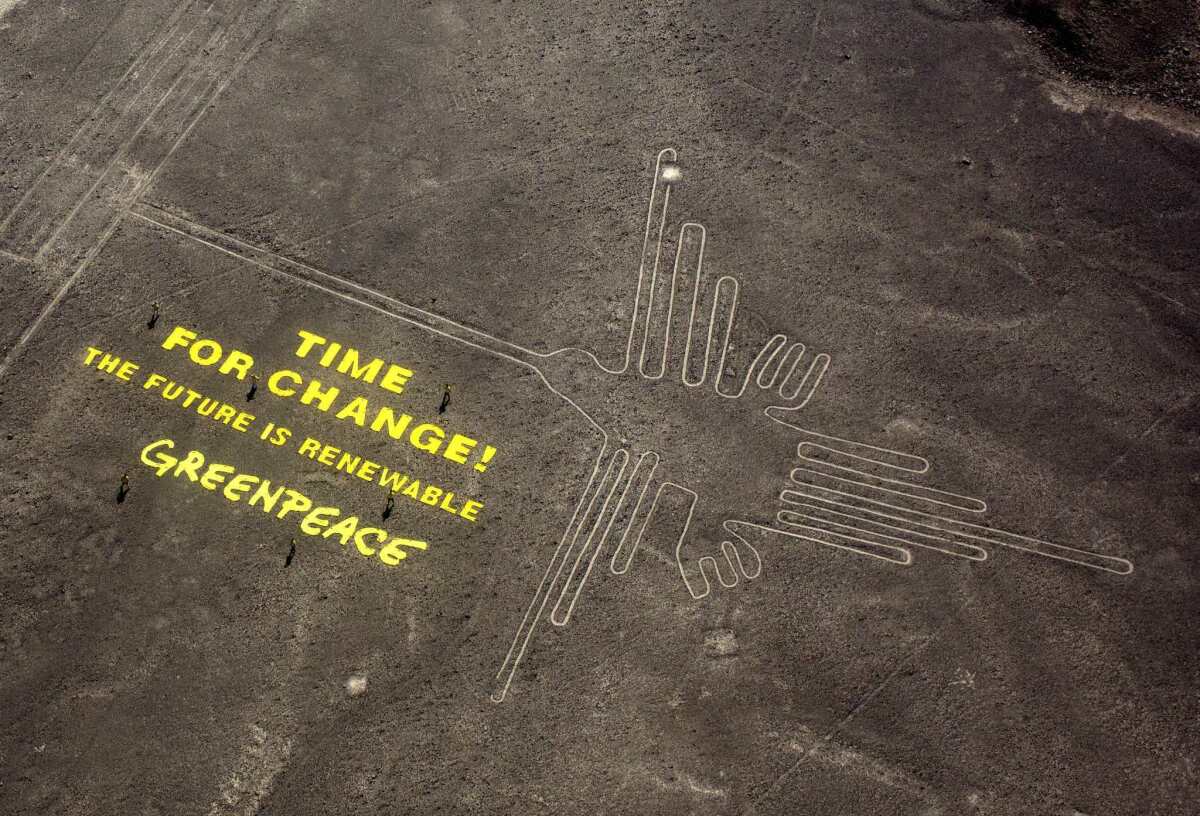Roundup: Botched restoration, Nazca Lines damage, auction house turmoil

Environmental activists anger archaeologists and the Peruvian government, a botched restoration draws pilgrims in Spain, the struggle to preserve a woman-built artist-environment in Wisconsin, as well as an iconic brutalist architectural icon in New York. Plus: an interview with MOCA curator and carnitas-lover Helen Molesworth, chief executive shuffle at the auction houses and the many mirrors of Craigslist. Roundup has moved to Monday. Here’s what we’re reading:
— Peru is seeking criminal charges against environmental activists from the group Greenpeace for damage to the fragile Nazca Lines archaeological site after they entered the protected grounds to install a massive pro-renewable-energy sign that could be seen from the air.
— Over a period of 15 years, a curator and two other employees at an Uzbek museum sold off some of its most significant works and replaced them with copies. If this weren’t such a travesty, I’d say it was a cheeky work of conceptual art.
— It’s not just the NSA: Museums are also mining your data. (ARTnews.)
— A botched restoration of a nearly century-old fresco of Jesus — a.k.a. “Beast Jesus” — turns a quiet Spanish town into a tourist center. (Artnet)
— Over decades, artist Mary Nohl transformed her home on the shores of Lake Michigan into a singular art environment. That environment is now in danger of being dismantled and moved (because the tony neighbors don’t want it there). A shame, this is one of the rare ones built entirely by a woman. Mary Louise Schumacher of the Journal-Sentinel has been a regular on this story.
— The buzz of the auction world: My colleague David Ng has a report on the chief executives of Sotheby’s and Christie’s, both of whom are departing their respective auction houses. Lots of art world tittering about this one.
— New York Magazine has a fascinating story about the assistant who earned painter Jasper Johns’ trust, then stole his work.
— The Museum of Modern Art has acquired a 3-D printed dress — and the software used to design it — for its permanent collection.
— L.A.’s Museum of Contemporary Art chief curator Helen Molesworth talks about what to expect in some of the museum’s upcoming shows. (Hint: more women.) Also, she likes carnitas. And on both of those fronts I have a deep and abiding respect.
— A new director is rethinking the visitor experience at the labyrinthine Louvre in Paris.
— Robert Smithson’s “Spiral Jetty” has inspired a new film (this one with actor Julian Sands). And arts writer Greg Allen, of Greg.org, isn’t exactly buying it.
— A 1930s Millard Sheets mural, which once hung in a Hollywood Hills home, will go to the Huntington in Pasadena.
— The world’s oldest trees in pictures. (Weisslink.)
— A report from music critic Mark Swed on the last Tower Records left standing in Tokyo.
— A photo essay of the personal effects of migrants who perished trying to make it across the Arizona desert. Powerful.
— On a related note, James Bridle has a fascinating essay at Creative Time that looks at how the idea of international borders has changed and expanded, turning large swaths of land into legal gray areas. For example, it is legal for the U.S. Border Patrol to search travelers within 100 miles of the border, which means that parts of the greater L.A. metropolitan area are subject to warrant-less search and seizure.
— On Friday, curator Thelma Golden, along with arts writer Hilton Als and historian Huey Copeland, gathered to discuss the legacy of the Whitney Museum’s 1994 exhibition “Black Male: Representations of Masculinity in Contemporary Art.” New York arts writer Robin Cembalest attended the panel and summarizes the discussion on what has changed and what hasn’t since that seminal show.
— Architectural firm Gwathmey Siegel is trying to preserve architect Paul Rudolph’s 1967 brutalist icon, the Government Center, in Goshen, N.Y., which has been under the threat of the wrecking ball.
— The French animated stop-motion sci-fi flick “La Planète Sauvage” (“Fantastic Planet”) from the early 1970s told the incredible, strange story of a future in which humans are kept as pets on an alien planet. The soundtrack by Alain Goraguer has been sampled by electronica and hip-hop musicians. It is now being re-released as special edition vinyl.
— Last but not least, a Tumblr of all the mirrors on Craigslist. Very Alice in Wonderland in only the best way imaginable.
Find me on Twitter @cmonstah.
More to Read
The biggest entertainment stories
Get our big stories about Hollywood, film, television, music, arts, culture and more right in your inbox as soon as they publish.
You may occasionally receive promotional content from the Los Angeles Times.







